Circular Wood Construction in a Sustainable Built Environment: A Thematic Review of Gaps and Emerging Topics
Abstract
1. Introduction
2. Methodology
- Key research directions;
- The most frequently addressed research problems and gaps in the literature;
- Examples of good practices and innovative design solutions.
- Well recognized;
- Moderately recognized;
- Niche and emerging.
3. Results of the Literature Review
3.1. Well Recognized
- -
- Reducing the carbon footprint through the use of wood: Wood has significant potential in reducing the carbon footprint due to its ability to sequester carbon over the long term, its ability to replace carbon-intensive building materials, and its use in cascade systems. The effectiveness of these strategies, however, depends on sustainable forest management, optimal use of wood raw materials, and properly targeted supporting policies. Under these conditions, wood can play a key role in mitigating the effects of climate change and supporting the transition to a sustainable built environment [20,21,22,23].
- -
- Mechanical properties of structural timber: The mechanical properties of structural timber are determined by its anisotropic structure, species variation, environmental factors and the microstructure of the material. Their accurate recognition is the basis for the rational and safe design of wooden structures. Advances in testing methods and the development of modern engineered materials, such as glulam and laminated wood, translate into higher performance and reliability in construction applications. As a result, wood is increasingly seen not only as an alternative to conventional materials, but as a durable, cost-effective and sustainable component of the built environment [24,25,26,27].
- -
- Prefabrication and standardization of wooden component: Prefabrication and standardization of wooden components in the construction industry are important tools for streamlining investment processes, contributing to increased realization efficiency, reduced environmental impact and expanded design possibilities. They enable better control over the quality and repeatability of components, reducing on-site assembly time and minimizing waste. The increasing automation of production further enhances the advantages of prefabrication, making it an attractive solution in terms of cost and technology. Despite these advantages, the successful large-scale implementation of prefabrication requires overcoming significant barriers, such as ensuring high manufacturing precision, integration with applicable standards, and aligning prefabricated solutions with accepted execution and engineering practices [28,29,30,31].
- -
- Life Cycle Analysis of Wooden Structures: Life cycle assessment is a key tool in analyzing the environmental impact of buildings, especially in the context of wooden structures, which show lower greenhouse effect potential (GWP) and lower energy consumption than traditional materials. However, the reliability of LCA results depends on the quality of the data and comprehensive coverage of all life cycle phases, including disassembly and end-of-life scenarios. Further methodological development remains a prerequisite for effectively promoting sustainable design in wood construction [32,33,34,35].
- -
- CE compliant design with wood: Designing with wood in the spirit of a circular economy is based on strategies aimed at efficient use of resources, minimizing waste and extending the life cycle of materials. Practices such as component reuse, reduced material waste and sustainable sourcing support both environmental and economic goals, making wood a key material in the transformation of construction toward a circular model [36,37].
3.2. Moderately Recognized
- -
- Recycling and reuse of wood in construction: Recycling and reuse of wood in construction are an important part of sustainable development strategies, contributing to emission reductions, resource savings, and economic benefits. Challenges related to quality, pollution, or market acceptance require support in the form of innovative technological solutions and appropriate regulations. Mainstreaming these practices into the construction industry promotes the goals of a circular economy [10,11,38,39].
- -
- Biodegradation and biological durability of wood in a closed cycle: Biodegradation and biological durability are key aspects of wood reuse in a closed cycle. Their control requires the integration of chemical modification methods, appropriate conservation treatments, and consideration of the impact of environmental conditions. Enhancing wood’s resilience through sustainable practices and modern testing methods is essential for extending its life cycle and reducing its environmental impact [40,41].
- -
- Integration of wood with other materials in hybrid structures: Hybrid structures involving wood combine the advantages of different materials, offering improved mechanical properties, increased durability, and a favorable environmental impact. Integration of wood with other components allows optimization of parameters such as fire resistance and sound insulation. These solutions represent a promising approach to sustainable design, but their full implementation requires further research and technological development [42,43].
- -
- Business models and closed-loop economics involving wood: The integration of closed-loop economics principles in the wood sector is based on the implementation of innovative business models, efficient waste management, and the development of new technologies and products. This transformation, despite the challenges, is a key component of a sustainable development strategy, offering tangible environmental and economic benefits [44].
- -
- Impact of regulatory standards and certification on sustainable wood use: Certifications such as FSC and PEFC play an important role in promoting sustainable forest management and wood use. However, their impact on market practice and design decisions in the construction industry requires further research [45,46].
3.3. Niche and Emerging Topics
- -
- Digital Life Cycle Tracking of Wood Elements: The use of digital technologies, such as Building Information Modeling (BIM) and Internet of Things (IoT), in life cycle tracking of wood elements is an area that is still developing. Research indicates the potential of these technologies in documenting materials, traceability, and reuse decisions (Section 4.1).
- -
- Upcycling of Low-Quality Wood: The processing of low-quality wood, such as wood from demolition, pallets, or packaging, into building materials with lower technical requirements is an area of research with great potential. Research is focused on developing technologies for the efficient use of such wood in construction (Section 4.2).
- -
- The Potential of Innovative Wood-Based Materials: New wood-based materials, such as recycled CLTs, offer opportunities for sustainable construction. However, their production and application in construction practice require further research and technology development (Section 4.3).
- -
- Social and Cultural Factors Influencing the Acceptance of Circular Economy Construction: Understanding the social and cultural aspects of CE construction acceptance is crucial to its widespread implementation. However, research in this area is limited and needs further development (Section 4.4).
4. Discussion on Niche and Emerging Topics
4.1. Digital Life Cycle Tracking of Wood Elements
4.2. Upcycling of Low-Quality Wood
4.3. The Potential of Innovative Wood-Based Materials
4.4. Social and Cultural Factors Influencing the Acceptance of Circular Economy Construction
5. Circular Wood Construction in Design Practice
6. Conclusions
Author Contributions
Funding
Acknowledgments
Conflicts of Interest
Abbreviations
| CE | Circular Economy |
| LCA | Life Cycle Assessment |
| BIM | Building Information Modeling |
| CLT | Cross-Laminated Timber |
| LVL | Laminated Veneer Lumber |
| CBP | Cement-Bonded Particleboard |
References
- Hosseini, Z.; Blanchet, P.; Laratte, B.; Cogulet, A. Evaluating circular economy strategies at the end-of-life stage of a mass timber building: Pathways for sustainable construction. Archit. Eng. Des. Manag. 2025, 1–21. [Google Scholar] [CrossRef]
- Finamore, M.; Oltean-Dumbrava, C. Circular economy in construction—Findings from a literature review. Heliyon 2024, 10, e34647. [Google Scholar] [CrossRef]
- Muntean, R.; Felseghi, R.-A.; Cobirzan, N. Eco-responsibility and circular economy in the green (sustainable) built environment. In Circular Economy Implementation for Sustainability in the Built Environment; Khan, M.A., Ed.; IGI Global: Hershey, PA, USA, 2023; pp. 57–83. [Google Scholar] [CrossRef]
- Awuzie, B.; Ngowi, A.; Aghimien, D. Towards built environment decarbonisation: A review of the role of artificial intelligence in improving energy and materials’ circularity performance. Energy Build. 2024, 319, 114491. [Google Scholar] [CrossRef]
- Rahla, K.M.; Mateus, R.; Bragança, L. Selection criteria for building materials and components in line with the circular economy principles in the built environment—A review of current trends. Infrastructures 2021, 6, 49. [Google Scholar] [CrossRef]
- Zallio, M.; Clarkson, P.J. Inclusion, diversity, equity and accessibility in the built environment: A study of architectural design practice. Build. Environ. 2021, 206, 108352. [Google Scholar] [CrossRef]
- Starzyk, A.; Rybak-Niedziółka, K.; Nowysz, A.; Marchwiński, J.; Kozarzewska, A.; Koszewska, J.; Piętocha, A.; Vietrova, P.; Łacek, P.; Donderewicz, M.; et al. New zero-carbon wooden building concepts: A review of selected criteria. Energies 2024, 17, 4502. [Google Scholar] [CrossRef]
- Government of the UK. Timber in Construction Roadmap. 2023. Available online: https://www.gov.uk/government/publications/timber-in-construction-roadmap-2025 (accessed on 23 June 2025).
- Waugh Thistleton Architects. Projects. Available online: https://waughthistleton.com/timber-policy (accessed on 23 June 2025).
- Tighnavard Balasbaneh, A.; Sher, W.; Ashour, A. Combining the circular economy and bio-based materials for alternative waste wood applications for the construction industry. Eng. Constr. Archit. Manag. 2025; Advance Online Publication. [Google Scholar] [CrossRef]
- Zhu, S.; Feng, H. Enhancing circularity of wood waste through deconstruction in building sector. J. Clean. Prod. 2024, 485, 144382. [Google Scholar] [CrossRef]
- Llana, D.F.; González-Alegre, V.; Portela, M.; Íñiguez-González, G. Cross Laminated Timber (CLT) Manufactured with European Oak Recovered from Demolition: Structural Properties and Non-Destructive Evaluation. Constr. Build. Mater. 2022, 339, 127635. [Google Scholar] [CrossRef]
- Tamke, M.; Svilans, T.; Huber, J.A.J.; Wuyts, W.; Thomsen, M.R. Non-Destructive Assessment of Reclaimed Timber Elements Using CT Scanning: Methods and Computational Modelling Framework. In Lecture Notes in Civil Engineering, Proceedings of the 1st International Conference on Net-Zero Built Environment, Nottingham, UK, 3–5 July 2024; Springer: Cham, Switzerland, 2025; Volume 237. [Google Scholar] [CrossRef]
- Böhm, F.; Richter, K.; Risse, M. Cascading potential of salvaged rafters from building demolition and deconstruction in southern Germany. J. Clean. Prod. 2025, 495, 144675. [Google Scholar] [CrossRef]
- Gómez-Gil, M.; Askar, R.; Karanafti, A.; Trubina, N.; Blázquez, T.; Güngör, B.; Bragança, L.; Leindecker, G. Unlocking the Potential of Material and Building Passports in the Transition to a Circular Economy in Buildings: A Critical Review. In Lecture Notes in Civil Engineering, Proceedings of the 4th International Conference “Coordinating Engineering for Sustainability and Resilience” & Midterm Conference of CircularB “Implementation of Circular Economy in the Built Environment” Timișoara, Romania, 29–31, May 2024; Springer: Cham, Switzerland, 2024; Volume 489. [Google Scholar] [CrossRef]
- Markou, I.; Sinnott, D.; Thomas, K. Current methodologies of creating material passports: A systematic literature review. Case Stud. Constr. Mater. 2025, 22, e04267. [Google Scholar] [CrossRef]
- Available online: https://time.com/7207873/sweden-stockholm-wood-city-sustainability/ (accessed on 23 June 2025).
- Available online: https://www.theguardian.com/environment/2025/apr/25/it-shapes-the-whole-experience-what-happens-when-you-build-a-city-from-wood (accessed on 23 June 2025).
- Available online: https://www.weforum.org/stories/2024/11/how-regional-mass-timber-markets-support-decarbonization-and-build-local-economies/ (accessed on 23 June 2025).
- Boiger, T.; Mair-Bauernfeind, C.; Asada, R.; Stern, T. Shifting wood between material and energy use: Modeling the effects of substitution. J. Ind. Ecol. 2024, 28, 1198–1211. [Google Scholar] [CrossRef]
- Marchetti, M.; Chirici, G.; Lasserre, B. Carbon losses due to wood harvesting and the role of wood products. In The Greenhouse Gas Balance of Italy; Valentini, R., Ed.; Springer: Berlin/Heidelberg, Germany, 2015; pp. 103–115. [Google Scholar] [CrossRef]
- D’Amico, B.; Pomponi, F.; Hart, J. Global potential for material substitution in building construction: The case of cross laminated timber. J. Clean. Prod. 2021, 279, 123487. [Google Scholar] [CrossRef]
- Abioye, S.O.; Oyedele, L.O.; Akanbi, L.; Ajayi, A.; Delgado, J.M.D.; Bilal, M.; Akinade, O.O.; Ahmed, A. Artificial intelligence in the construction industry: A review of present status, opportunities and future challenges. J. Build. Eng. 2021, 44, 103299. [Google Scholar] [CrossRef]
- Ajuong, E.; Pinion, L.C. Degradation of wood. In Shreir’s Corrosion; Cottis, B., Ed.; Elsevier: Amsterdam, The Netherlands, 2010; Volume 3, pp. 2439–2446. [Google Scholar] [CrossRef]
- Sheikh, U.A.; Jameel, A.; Rasool, M.; Mir, M.J. Enriched techniques for investigating the behavior of structural wood. In Enriched Numerical Techniques: Implementation and Applications; Elsevier: Amsterdam, The Netherlands, 2024; pp. 379–391. [Google Scholar] [CrossRef]
- Bayramoglu, M.M.; Demir, A.; Birinci, A.U.; Ozturk, H.; Ilhan, O.; Candan, Z.; Demirkir, C. Effect of lumber quality grade on the mechanical properties and product costs of cross-laminated timber panels. BioResources 2025, 20, 3519–3533. [Google Scholar] [CrossRef]
- Li, H.; Wang, L.; Wei, Y.; Wang, B.J.; Jin, H. Bending and shear performance of cross-laminated timber and glued-laminated timber beams: A comparative investigation. J. Build. Eng. 2021, 45, 103477. [Google Scholar] [CrossRef]
- Koppelhuber, J.; Bauer, B.; Wall, J.; Heck, D. Industrialized Timber Building Systems for an Increased Market Share—A Holistic Approach Targeting Construction Management and Building Economics. Procedia Eng. 2017, 171, 333–340. [Google Scholar] [CrossRef]
- Chippagiri, R.; Bras, A.; Sharma, D.; Ralegaonkar, R.V. Technological and Sustainable Perception on the Advancements of Prefabrication in Construction Industry. Energies 2022, 15, 7548. [Google Scholar] [CrossRef]
- Wilk, K. The Use of a Prefabricated Mass Timber Structure in the Design of Single-Family Houses in Terms of Sustainable Development. In Environmental Challenges in Civil Engineering, 2nd ed.; Springer: Cham, Switzerland, 2023; pp. 226–233. [Google Scholar] [CrossRef]
- Pasetti Monizza, G.; Rauch, E.; Matt, D.T. Parametric and Generative Design Techniques for Mass-Customization in Building Industry: A Case Study for Glued-Laminated Timber. Procedia CIRP 2017, 60, 392–397. [Google Scholar] [CrossRef]
- Lin, C.L.; Chiang, W.; Weng, Y.; Wu, H. Assessing anthropogenic carbon emission of wooden construction: An LCA study. Build. Res. Inf. 2023, 51, 138–157. [Google Scholar] [CrossRef]
- Ilgın, H.E.; Saviharju, A.; Karjalainen, M.; Hirvilammi, T. Life Cycle Assessment of an Office Building in Finland Using a Custom Assessment Tool. Buildings 2024, 14, 1944. [Google Scholar] [CrossRef]
- Takano, A.; Hafner, A.; Linkosalmi, L.; Ott, S.; Hughes, M.; Winter, S. Life cycle assessment of wood construction according to the normative standards. Eur. J. Wood Prod. 2015, 73, 299–312. [Google Scholar] [CrossRef]
- Hansen, R.N.; Eliassen, J.L.; Schmidt, J.; Andersen, C.E.; Weidema, B.P.; Birgisdóttir, H.; Hoxha, E. Environmental consequences of shifting to timber construction: The case of Denmark. Sustain. Prod. Consum. 2024, 46, 54–67. [Google Scholar] [CrossRef]
- Birk, S.; Schuster, S. Kreislauffähiger Holzbau—Entwerfen für die Wiederverwendung. Bautechnik 2025, 102, 65–71. [Google Scholar] [CrossRef]
- Parigi, D. Minimal-waste design of timber layouts from non-standard reclaimed elements: A combinatorial approach based on structural reciprocity. Int. J. Space Struct. 2021, 36, 270–280. [Google Scholar] [CrossRef]
- Shahidul, M.I.; Malcolm, M.L.; Hashmi, M.S.J.; Alhaji, M.H. Waste Resources Recycling in Achieving Economic and Environmental Sustainability: Review on Wood Waste Industry. In Encyclopedia of Renewable and Sustainable Materials; Elsevier: Amsterdam, The Netherlands, 2020; pp. 965–974. [Google Scholar] [CrossRef]
- Abdolmaleki, H.; Ahmadi, Z.; Hashemi, E.; Talebi, S. A review of the circular economy approach to the construction and demolition wood waste: A 4 R principle perspective. Clean. Waste Syst. 2025, 11, 100248. [Google Scholar] [CrossRef]
- Marais, B.N.; Brischke, C.; Militz, H. Wood durability in terrestrial and aquatic environments—A review of biotic and abiotic influence factors. Wood Mater. Sci. Eng. 2022, 17, 82–105. [Google Scholar] [CrossRef]
- Martín, J.A.; López, R. Biological Deterioration and Natural Durability of Wood in Europe. Forests 2023, 14, 283. [Google Scholar] [CrossRef]
- Pastori, S.; Mazzucchelli, E.S.; Wallhagen, M. Hybrid timber-based structures: A state of the art review. Constr. Build. Mater. 2022, 359, 129505. [Google Scholar] [CrossRef]
- Zhang, X.; Huang, W.; Khajehpour, M.; Asgari, M.; Tannert, T. Seismic performance and LCA comparison between concrete and timber–concrete hybrid buildings. Buildings 2023, 13, 1714. [Google Scholar] [CrossRef]
- Hasibuan, G.C.R.; Al Fath, M.T.; Yusof, N.; Dewi, R.A.; Syafridon, G.G.A.; Jaya, I.; Anas, M.R. Integrating circular economy into construction and demolition waste management: A bibliometric review of sustainable engineering practices in the built environment. Case Stud. Chem. Environ. Eng. 2025, 11, 101159. [Google Scholar] [CrossRef]
- Paluš, H.; Parobek, J.; Vlosky, R.P.; Motik, D.; Oblak, L.; Jošt, M.; Glavonjić, B.; Dudík, R.; Wanat, L. The status of chain-of-custody certification in the countries of Central and South Europe. Eur. J. Wood Wood Prod. 2018, 76, 699–710. [Google Scholar] [CrossRef]
- Guan, Z.; Xu, Y.; Ip Ping Sheong, J. The impact of application of FSC Chain of Custody certification on global wood products trade. Eur. J. Wood Wood Prod. 2019, 77, 633–643. [Google Scholar] [CrossRef]
- Seitz, C.; Legat, C.; Liu, Z. Flexible manufacturing control with autonomous product memories. In Proceedings of the 2010 IEEE 15th Conference on Emerging Technologies and Factory Automation (ETFA), Bilbao, Spain, 13–16 September 2010. [Google Scholar] [CrossRef]
- Pichler, G.; Sandak, J.; Picchi, G.; Kastner, M.; Graifenberg, D.; Stampfer, K.; Kühmaier, M. Timber Tracking in a Mountain Forest Supply Chain: A Case Study to Analyze Functionality, Bottlenecks, Risks, and Costs. Forests 2022, 13, 1373. [Google Scholar] [CrossRef]
- Björk, A.; Erlandsson, M.; Häkli, J.; Jaakkola, K.; Nilsson, Å.; Nummila, K.; Puntanen, V.; Sirkka, A. Monitoring environmental performance of the forestry supply chain using RFID. Comput. Ind. 2011, 62, 830–841. [Google Scholar] [CrossRef]
- Su Kyaw, K.S.; Huang, L.; Liu, Y.; Bohne, R.A. Influences of BIM-LOD and Geographic-Scale Environmental Impact Factors on embodied emissions: The Norwegian context. Build. Environ. 2024, 269, 112345. [Google Scholar] [CrossRef]
- Ximenes, F.A.; Grant, T. Quantifying the greenhouse benefits of the use of wood products in two popular house designs in Sydney, Australia. Int. J. Life Cycle Assess. 2013, 18, 891–908. [Google Scholar] [CrossRef]
- Gharaibeh, L.; Matarneh, S.; Eriksson, K.; Lantz, B. Digital transformation of the wood construction supply chain through building information modelling: Current state of practice. Constr. Innov. 2024, 24, 273–291. [Google Scholar] [CrossRef]
- Elginoz, N.; van Blokland, J.; Safarian, S.; Movahedisaveji, Z.; Yadeta Wedajo, D.; Adamopoulos, S. Wood Waste Recycling in Sweden—Industrial, Environmental, Social, and Economic Challenges and Benefits. Sustainability 2024, 16, 5933. [Google Scholar] [CrossRef]
- Leone, R.; Campisi, T.; Saeli, M. Wood Industry Wastes Valorisation and Reuse for a Greener Architecture. In Lecture Notes in Civil Engineering, Proceedings of the 11th International Conference of Ar.Tec. (Scientific Society of Architectural Engineering), Palermo, Italy, 12–15 June 2024; Springer: Cham, Switzerland, 2024; Volume 611. [Google Scholar] [CrossRef]
- Smetanková, J. Database of building information models—Identification and design of parameter structure. In Proceedings of the IOP Conference Series: Materials Science and Engineering, London, UK, 5–6 October 2020; Volume 867, p. 012037. [Google Scholar] [CrossRef]
- Sheina, S.; Girya, L.; Aleksandrova, Y. Sustainable Development of the Construction of Buildings for Educational Institutions. In Lecture Notes in Networks and Systems, Proceedings of the XV International Scientific Conference “INTERAGROMASH 2022”, Rostov-on-Don, Russia, 2–4 March 2022; Springer: Cham, Switzerland, 2023; Volume 575. [Google Scholar] [CrossRef]
- Zhang, Y.; Meina, A.; Lin, X.; Zhang, K.; Xu, Z. Digital Twin in Computational Design and Robotic Construction of Wooden Architecture. Adv. Civ. Eng. 2021, 2021, 8898997. [Google Scholar] [CrossRef]
- Mazur, Ł.; Olenchuk, A. Life Cycle Assessment and Building Information Modeling Integrated Approach: Carbon Footprint of Masonry and Timber-Frame Constructions in Single-Family Houses. Sustainability 2023, 15, 15486. [Google Scholar] [CrossRef]
- Göswein, V.; Carvalho, S.; Cerqueira, C.; Lorena, A. Circular material passports for buildings—Providing a robust methodology for promoting circular buildings. In Proceedings of the IOP Conference Series: Earth and Environmental Science 2022, Depok, Indonesia, 29–30 November 2022; Volume 1122, p. 012049. [Google Scholar] [CrossRef]
- Kunic, A.; Talaei, A.; Naboni, R. Cyber–physical infrastructure for material and construction data tracking in reconfigurable timber light-frame structures. Constr. Robot. 2025, 9, 11. [Google Scholar] [CrossRef]
- Banihashemi, S.; Meskin, S.; Sheikhkhoshkar, M.; Mohandes, S.R.; Hajirasouli, A.; LeNguyen, K. Circular economy in construction: The digital transformation perspective. Clean. Eng. Technol. 2024, 18, 100715. [Google Scholar] [CrossRef]
- Thirumal, S.; Udawatta, N.; Karunasena, G.; Al-Ameri, R. Barriers to Adopting Digital Technologies to Implement Circular Economy Practices in the Construction Industry: A Systematic Literature Review. Sustainability 2024, 16, 3185. [Google Scholar] [CrossRef]
- Mojica, A.; Serrano-Ruiz, J.C.; Andres, B.; de la Torre, R. A Conceptual Framework for the Upcycling Supply Chain in the Wood Sector. Sustainability 2025, 17, 1006. [Google Scholar] [CrossRef]
- Sung, K.; Abuzeinab, A. Challenges and Opportunities for Scaling Up Global Upcycling Towards Sustainable Production and Consumption. In Handbook of Sustainability Science in the Future; Springer: Cham, Switzerland, 2023; pp. 1679–1697. [Google Scholar] [CrossRef]
- Galila, A.; Kaseireldeil, S.; Abdalkhaliq, N.; Farouk, E.; Eichner, M.; Sarhan, Y. Enhancing sustainability and resource efficiency through upcycling: A comprehensive review and analytical—Based framework for evaluating building upcycled products. Innov. Infrastruct. Solut. 2024, 9, 270. [Google Scholar] [CrossRef]
- Almusaed, A.; Yitmen, I.; Almsaad, A.; Akiner, İ.; Akiner, M.E. Coherent Investigation on a Smart Kinetic Wooden Façade Based on Material Passport Concepts and Environmental Profile Inquiry. Materials 2021, 14, 3771. [Google Scholar] [CrossRef] [PubMed]
- Rose, C.M.; Bergsagel, D.; Dufresne, T.; Unubreme, E.; Lyu, T.; Duffour, P.; Stegemann, J.A. Cross-Laminated Secondary Timber: Experimental Testing and Modelling the Effect of Defects and Reduced Feedstock Properties. Sustainability 2018, 10, 4118. [Google Scholar] [CrossRef]
- Gnacy, N.; Werbińska-Wojciechowska, S. Supply Chain Digital Maturity Modeling—A Case Study of a Wood-Based Supply Chain. In TRANSBALTICA XIV: Transportation Science and Technology; Lecture Notes in Intelligent Transportation and Infrastructure; Springer: Cham, Switzerland, 2024. [Google Scholar] [CrossRef]
- Hossain, M.U.; Wang, L.; Yu, I.K.M.; Tsang, D.C.W.; Poon, C.S. Environmental and technical feasibility study of upcycling wood waste into cement-bonded particleboard. Constr. Build. Mater. 2018, 173, 474–480. [Google Scholar] [CrossRef]
- Vonk, N.H.; Niederwestberg, J.; Oorschot, R.W.A.; de Jong, J. Upcycling of Single-Use Pallet Wood to Cross-Laminated Timber. In Lecture Notes in Civil Engineering, Proceedings of the the 1st International Conference on Net-Zero Built Environment, Oslo, Norway, 19–21 June 2024; Springer: Cham, Switzerland, 2025; Volume 237. [Google Scholar] [CrossRef]
- Kręt-Grześkowiak, A.; Bruhn, S.; Jensen, A.A.V.; Birkved, M. Quantifying the environmental impact of structural timber across multiple future lifecycles. Discov. Appl. Sci. 2024, 6, 197. [Google Scholar] [CrossRef]
- Hossain, M.U.; Poon, C.S. Comparative LCA of wood waste management strategies generated from building construction activities. J. Clean. Prod. 2018, 177, 387–397. [Google Scholar] [CrossRef]
- Paragliola, F.; Galluccio, G.; Ermolli, S.R.; Perriccioli, M.; Rigillo, M.; Giannino, F. Stirring digital innovation in wood waste upcycling: System dynamics as a circular design decision-making methodology. In Proceedings of the IOP Conference Series: Earth and Environmental Science: Tashkent, Uzbekistan, 17–19 October 2024; Volume 1402, p. 012030. [Google Scholar] [CrossRef]
- Hurmekoski, E.; Jonsson, R.; Korhonen, J.; Jänis, J.; Mäkinen, M.; Leskinen, P.; Hetemäki, L. Diversification of the forest industries: Role of new wood-based products. Can. J. For. Res. 2018, 48, 1417–1432. [Google Scholar] [CrossRef]
- Ormondroyd, G.A.; Spear, M.J.; Skinner, C. The Opportunities and Challenges for Re-use and Recycling of Timber and Wood Products Within the Construction Sector. In Environmental Impacts of Traditional and Innovative Forest-Based Bioproducts; Environmental Footprints and Eco-design of Products and Processes; Springer: Singapore, 2016. [Google Scholar] [CrossRef]
- Maier, D. Building Materials Made of Wood Waste a Solution to Achieve the Sustainable Development Goals. Materials 2021, 14, 7638. [Google Scholar] [CrossRef] [PubMed]
- Jahan, I.; Zhang, G.; Bhuiyan, M.; Navaratnam, S. Circular Economy of Construction and Demolition Wood Waste—A Theoretical Framework Approach. Sustainability 2022, 14, 10478. [Google Scholar] [CrossRef]
- Available online: https://www.globenewswire.com/news-release/2024/12/12/2996264/0/en/Cross-Laminated-Timber-Market-Projected-to-Reach-USD-4-1-Billion-by-2032-Rising-Demand-for-Sustainable-Construction-Drives-Market-Expansion.html (accessed on 23 June 2025).
- Hassegawa, M.; Karlberg, A.; Hertzberg, M.; Verkerk, P.J. Innovative forest products in the circular bioeconomy. Open Res. Europe. 2022, 2, 19. [Google Scholar] [CrossRef]
- Sotayo, A.; Bradley, D.; Bather, M.; Sareh, P.; Oudjene, M.; El-Houjeyri, I.; Harte, A.M.; Mehra, S.; O’Ceallaigh, C.; Haller, P.; et al. Review of State of the Art of Dowel Laminated Timber Members and Densified Wood Materials as Sustainable Engineered Wood Products for Construction and Building Applications. Dev. Built Environ. 2020, 1, 100004. [Google Scholar] [CrossRef]
- Winchester, N.; Reilly, J.M. The economic and emissions benefits of engineered wood products in a low-carbon future. Energy Econ. 2020, 85, 104596. [Google Scholar] [CrossRef]
- Svobodová, H.; Hlaváčková, P. Forest as a source of renewable material to reduce the environmental impact of buildings. J. For. Sci. 2023, 69, 451–462. [Google Scholar] [CrossRef]
- Cabral, M.R.; Blanchet, P. A State of the Art of the Overall Energy Efficiency of Wood Buildings—An Overview and Future Possibilities. Materials 2021, 14, 1848. [Google Scholar] [CrossRef]
- Andriyanov, S.; Lukina, A.; Tuzhilova, M. Transformation of the Role of Wood as a Building Material. In Proceedings of the International Conference on Materials Physics, Building Structures & Technologies in Construction, Industrial and Production Engineering–MPCPE, Vladimir, Russia, 28–30 April 2025; Springer: Cham, Switzerland, 2025; Volume 576, pp. 27–35. [Google Scholar] [CrossRef]
- Sandak, A.; Brzezicki, M.; Sandak, J. Trends and perspectives in the use of timber and derived products in building façades. In New Materials in Civil Engineering; Samui, P., Ed.; Butterworth-Heinemann: Oxford, UK, 2020; pp. 333–374. [Google Scholar] [CrossRef]
- Mazur, Ł. Sustainable Architecture: Innovations and Perspectives for Multifamily Housing in Timber-Based Structures. Eng. Proc. 2023, 53, 43. [Google Scholar] [CrossRef]
- Beims, R.F.; Arredondo, R.; Carrero, D.J.S.; Yuan, Z.; Li, H.; Shui, H.; Zhang, Y.; Leitch, M.; Xu, C.C. Functionalized wood as bio-based advanced materials: Properties, applications, and challenges. Renew. Sustain. Energy Rev. 2022, 157, 112074. [Google Scholar] [CrossRef]
- Ranacher, L.; Höfferer, K.; Lettner, M.; Hesser, F.; Stern, T.; Rauter, R.; Schwarzbauer, P. What would potential future opinion leaders like to know? An explorative study on the perceptions of four wood-based innovations. Die Bodenkult. J. Land Manag. Food Environ. 2018, 69, 47–59. [Google Scholar] [CrossRef]
- Low, S.P.; Gao, S.; Ng, S.K. The adoption of mass-engineered timber (MET) in the Singapore construction industry: Barriers and drivers. J. Clean. Prod. 2021, 327, 129430. [Google Scholar] [CrossRef]
- Miletzky, F.; Wagenführ, A.; Zscheile, M. Wood-Based Bioeconomy. In The Bioeconomy System; Springer: Berlin, Heidelberg, 2022; pp. 49–65. [Google Scholar] [CrossRef]
- Mitrenova, E.; Aichholzer, M.; Santana-Sosa, A. HIBIWOOD—Didactic approaches for academic education on multi-storey timber buildings. In Proceedings of the World Conference on Timber Engineering, Oslo, Norway, 19–22 June 2023; pp. 4590–4596. [Google Scholar] [CrossRef]
- Eskelinen, T.; Sydd, O.; Kajanus, M.; Fernández Gutiérrez, D.; Mitsou, M.; Soriano Disla, J.M.; Sevilla, M.V.; Ib Hansen, J. Fortifying Social Acceptance When Designing Circular Economy Business Models on Biowaste Related Products. Sustainability 2022, 14, 14983. [Google Scholar] [CrossRef]
- Foster, G. Circular economy strategies for adaptive reuse of cultural heritage buildings to reduce environmental impacts. Resour. Conserv. Recycl. 2020, 152, 104507. [Google Scholar] [CrossRef]
- Rao, P.A.; Rahman, M.M.; Duraman, S.B. Adopting circular economy in construction: A review. Front. Built. Environ. 2025, 11, 1519219. [Google Scholar] [CrossRef]
- Snohetta. Available online: https://www.snohetta.com/ (accessed on 31 July 2025).
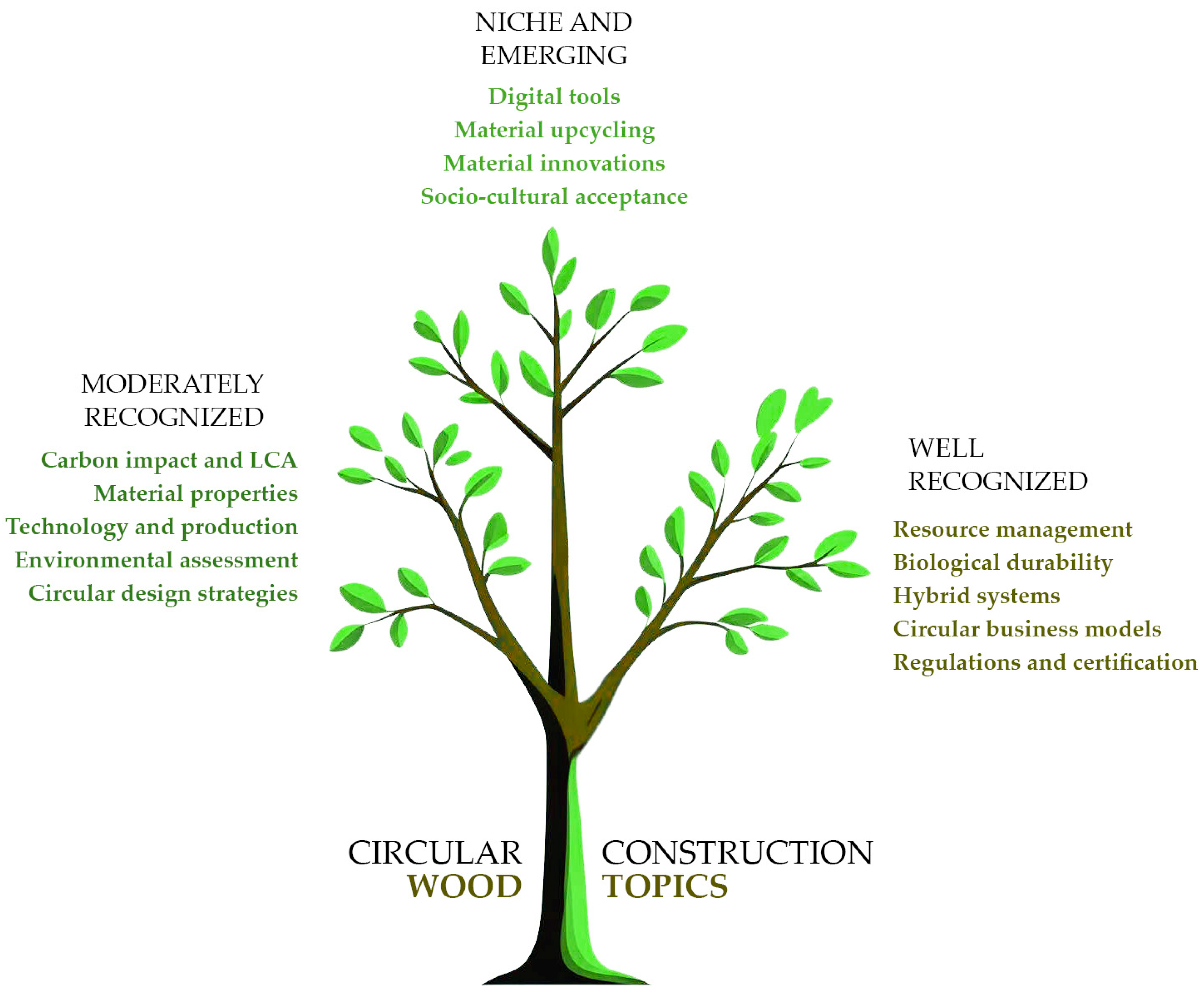
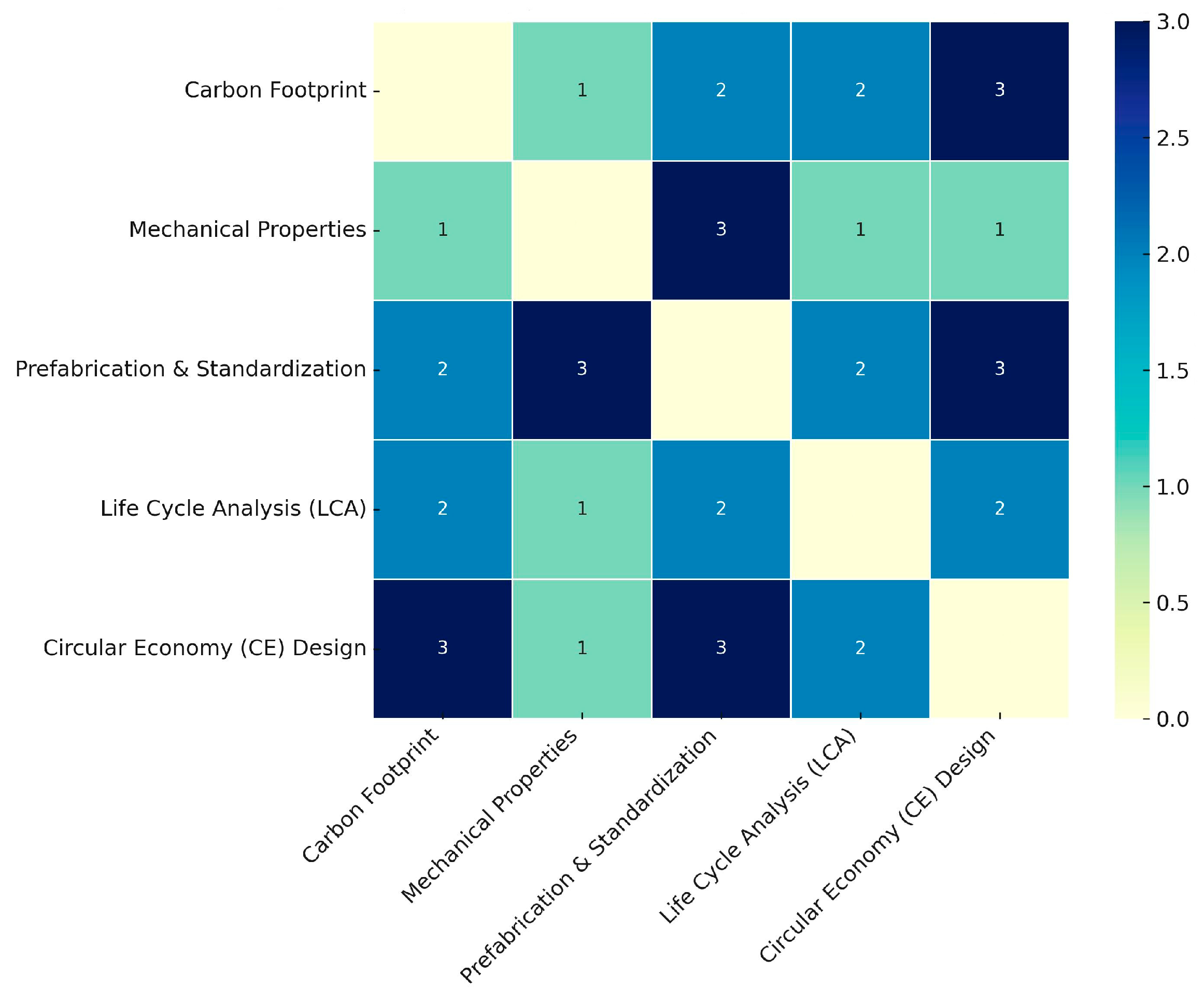
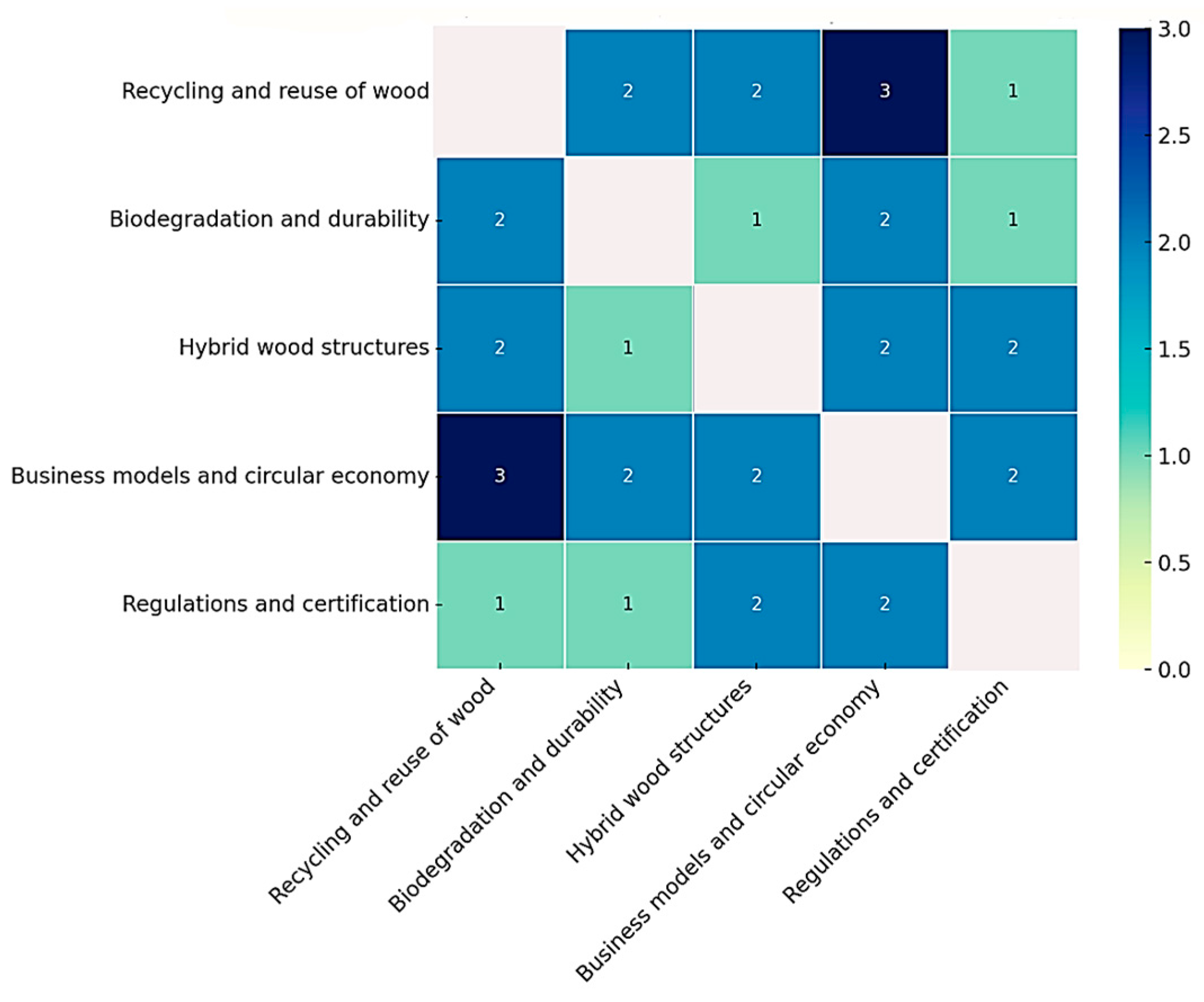
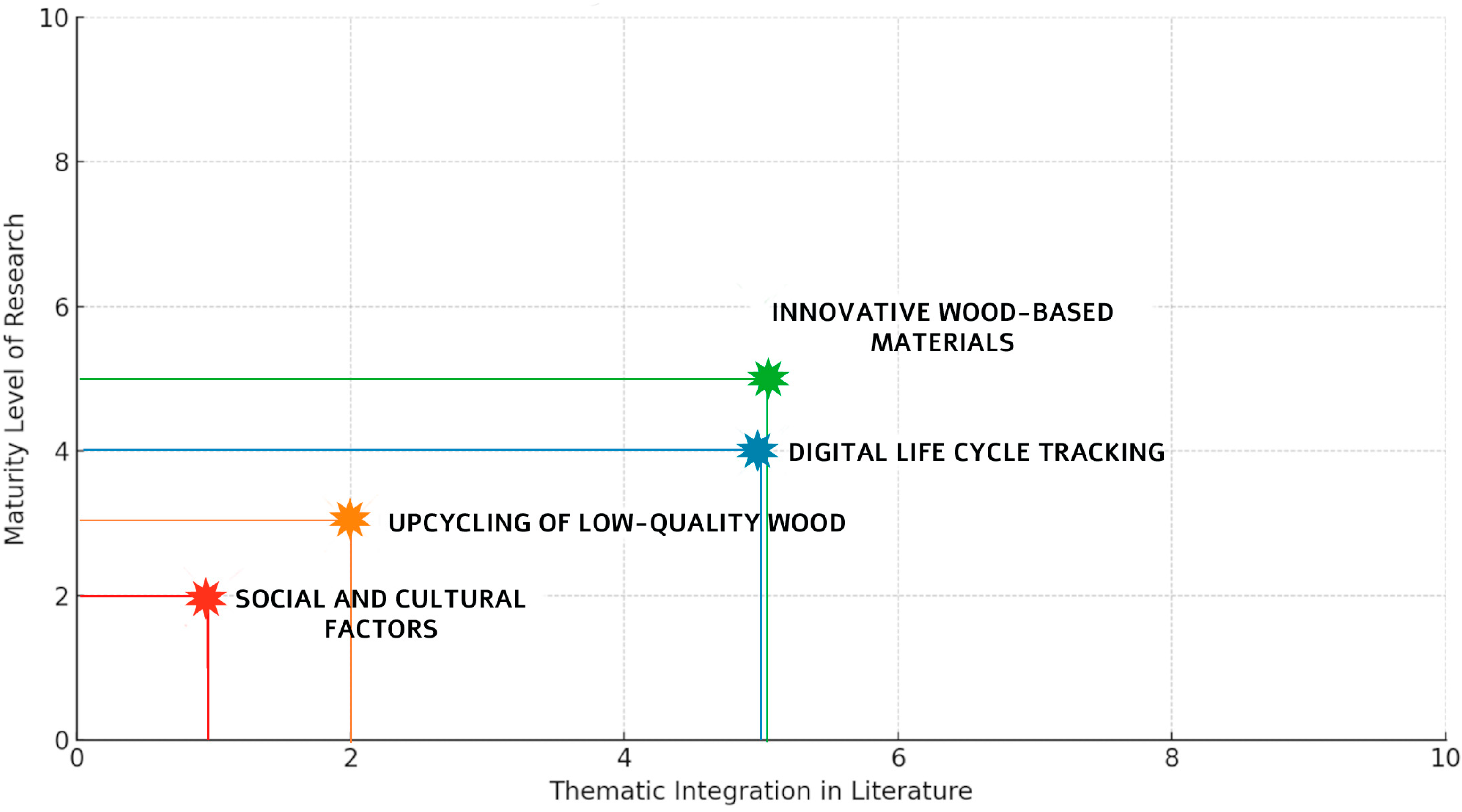
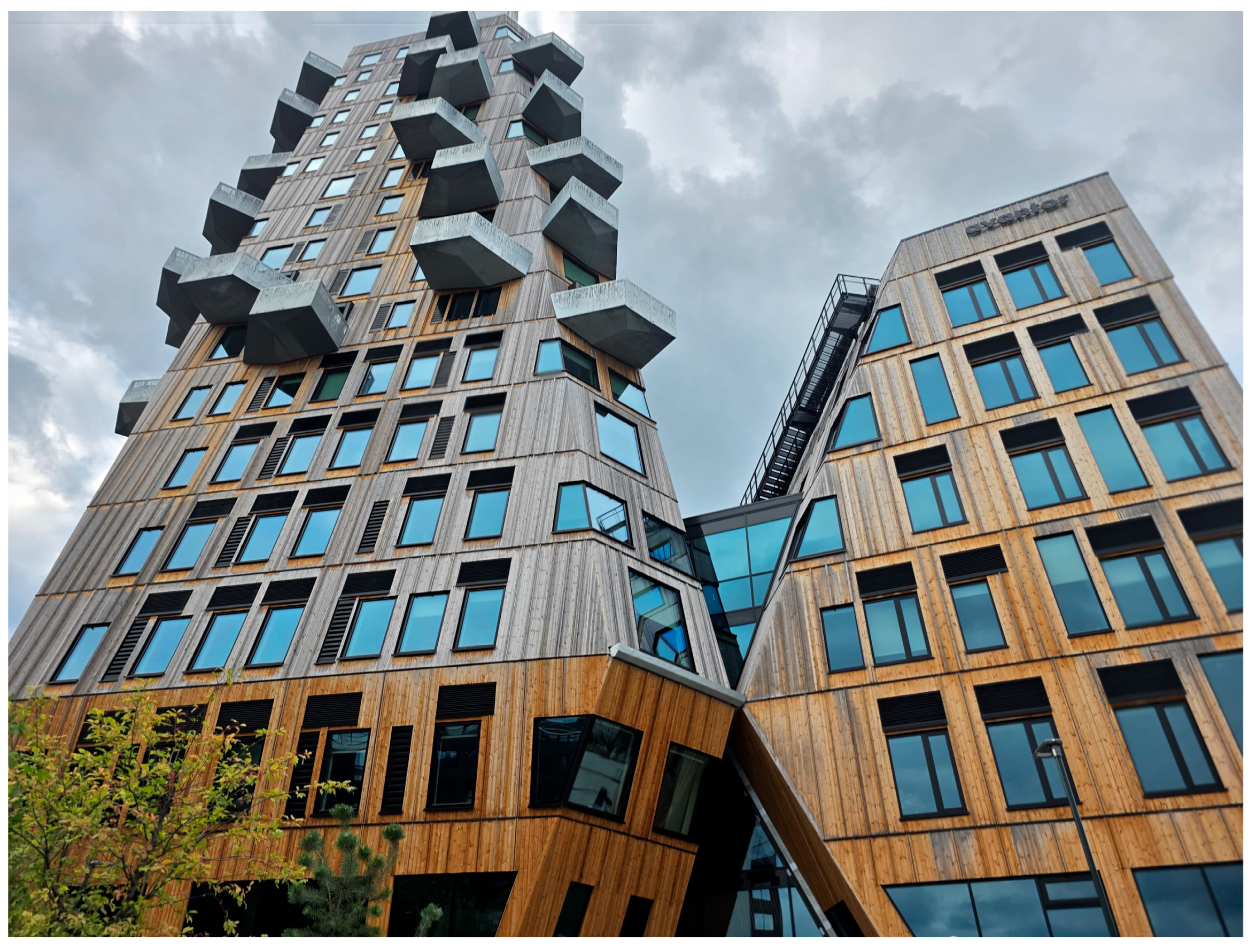
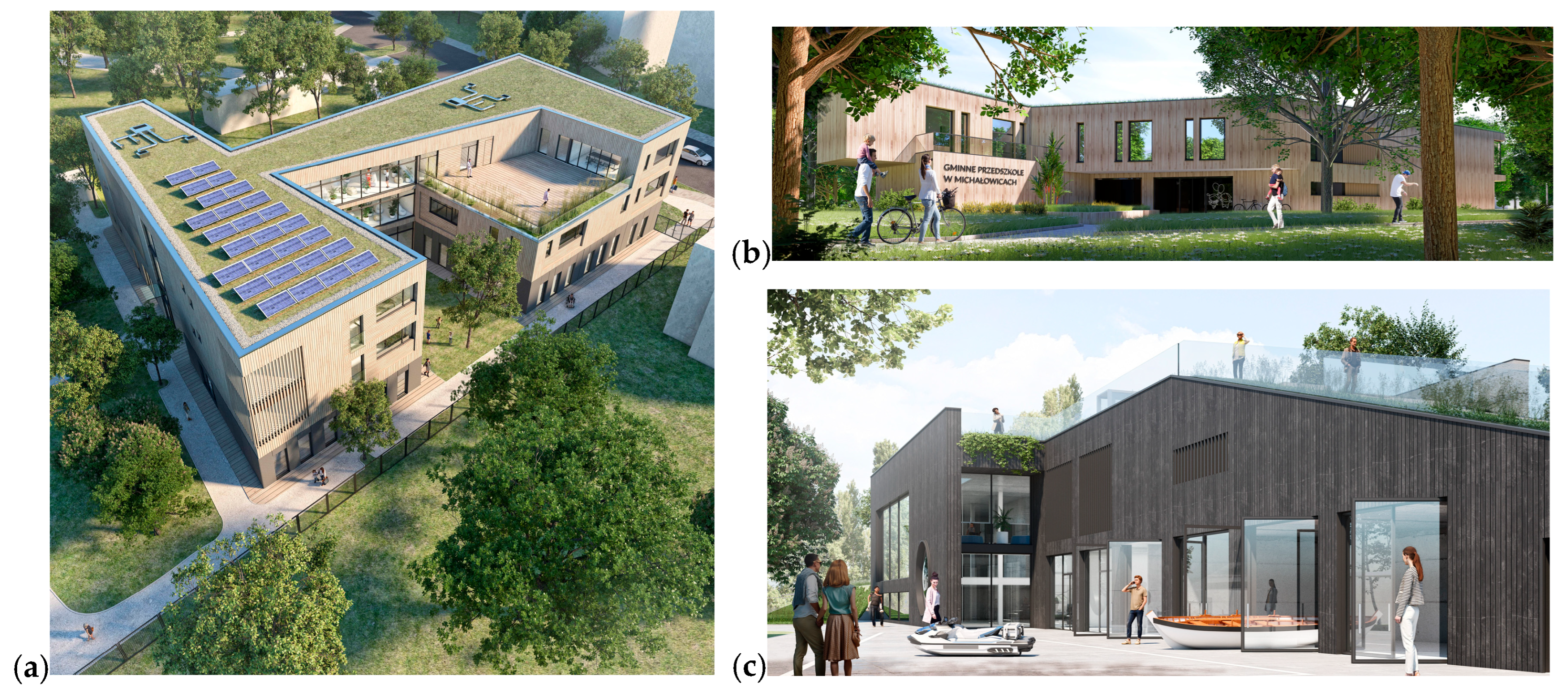
| Analysis Stage | Description | Specific Objective |
|---|---|---|
| Stage of Analysis | Critical review of scientific literature concerning the use of wood in sustainable construction within the circular economy context; identification of research challenges at three recognition levels: well established, moderately addressed, and niche/emerging. | Identify research gaps, particularly in underexplored or emerging areas; strengthen the role of interdisciplinary approaches integrating design, technological, and social knowledge. |
| Source Selection | Selection of peer-reviewed publications indexed in Scopus and Web of Science; additional use of ScienceDirect, SpringerLink, MDPI, and Taylor & Francis sources, provided they are also indexed in Scopus. | Ensure scientific quality, topical relevance, and thematic diversity of the analyzed sources. |
| Publication Criteria | Included works focus on wood as a sustainable material within CE frameworks; full-text availability and DOI required. | Exclude purely technical publications lacking relevance to design, societal, or environmental contexts. |
| Search Strategies | Used keyword combinations such as engineered wood, circular economy, wood recycling, LCA, digital material passport; also applied backward reference checking in frequently cited publications. | Gather a wide-ranging, interdisciplinary literature sample to support thematic identification. |
| Content Analysis Approach | Three-stage thematic-problem analysis: article categorization, comparative review of methodologies, and identification of challenges and knowledge gaps; qualitative evaluation considering technological, design, and cultural aspects. | Organize research challenges and highlight topics with significant cognitive or application potential. |
| Typology of Research Topics | Issues classified into three levels: well established (e.g., carbon footprint, prefabrication), moderately addressed (e.g., recycling, biodegradation, business models), and niche/emerging (e.g., digital material passports, upcycling, innovative wood-based materials, socio-cultural aspects). | Demonstrate topic maturity and scientific grounding while identifying areas requiring further exploration. |
| Research Perspective | Interdisciplinary perspective of the architect-designer, combining scientific insight with project intuition and cultural reflection. | Promote the relevance of design- and culture-driven research in the development of sustainable timber construction. |
| Methodological Limitations | Focus restricted to indexed sources; literature in languages other than English and Polish excluded; academic lens prevails over implementation-oriented perspectives. | Openly acknowledge methodological boundaries and potential limitations impacting findings. |
| Recognition Level | Topic Category | Research Focus | Problem Description | Future Research Directions |
|---|---|---|---|---|
| Well recognized | Carbon impact and LCA | Reducing the carbon footprint through the use of wood | Utilizing wood to lower the carbon footprint due to its carbon sequestration capacity and substitution of carbon-intensive materials. | Standardizing LCA methods; including end-of-life and reuse scenarios in assessments. |
| Material properties | Mechanical properties of structural timber | Influence of species, moisture, and microstructure; advancement of engineered products like CLT and glulam. | Further studies on durability in changing climate conditions; applications in multi-story construction. | |
| Technology and production | Prefabrication and standardization of wooden components | Factory-based solutions improve quality, reduce waste, and increase construction efficiency. | Integration with parametric design and building standards. | |
| Environmental assessment | Life Cycle Analysis of wooden structures | Comparative LCA with conventional materials; sensitivity to data quality and scope of the analysis. | Development of comprehensive and dynamic LCA models for wood. | |
| Circular design strategies | CE compliant design with wood | Reuse, material efficiency, design for disassembly; focus on resource optimization. | Case-based evaluation of CE implementation and supporting design tools. | |
| Moderately recognized | Resource management | Recycling and reuse of wood in construction | Technical, economic, and normative barriers such as contamination, standardization, and variable properties. | Advanced diagnostics, quality classification systems, and material logistics support. |
| Biological durability | Biodegradation and biological durability of wood in a closed cycle | Impact of biological agents and environment on secondary wood lifespan. | Application of chemical/biological treatments and longevity testing. | |
| Hybrid systems | Integration of wood with other materials | Hybrid solutions enhance fire, acoustic, and mechanical performance. | Validation of long-term durability and environmental performance. | |
| Circular business models | Business models for CE involving wood | Sustainable production-consumption models for timber in the built environment. | Feasibility studies, implementation strategies, scalability analysis. | |
| Regulations and certification | Impact of regulatory standards and certification | Role of FSC, PEFC certifications in shaping design practices and supply chains. | Effectiveness of certification and integration into building design processes. | |
| Niche and emerging | Digital tools | Digital life cycle tracking of wood components | Use of BIM, IoT, and material passports for identification, monitoring, and reuse. | Standardization of data, development of interoperable digital platforms. |
| Material upcycling | Upcycling of low-quality wood | Transforming low-grade wood (e.g., pallets, demolition timber) into higher-value construction components. | Technological efficiency studies, mechanical properties, life cycle and cost analysis. | |
| Material innovations | Innovative wood-based materials | Biocomposites, transparent wood, lignocellulosic foams, and biopolymers for multifunctional uses. | Certification and performance validation, adaptation to building codes. | |
| Socio-cultural acceptance | Social and cultural acceptance of CE-based wood construction | Influenced by education, trust in technology, and esthetic perception. | Participatory research, communication strategies, adaptation to local cultures. |
| Thematic Area | Key Discussion Insights | Research Implications | Practical Implications |
|---|---|---|---|
| Digital life cycle tracking (DMP, BIM, IoT) | Material passports and digital twins offer significant potential to enhance traceability and transparency of wood products across their life cycle, yet challenges remain regarding standardization and interoperability. | Further studies are needed to integrate BIM environments with circular economy models and material traceability systems. | Developing standardized digital tools for material monitoring across design and operational phases. |
| Upcycling of low-quality wood | Upcycling demolition timber is technically feasible but requires improved processing technologies and validation of functional performance. | Evaluate environmental and material efficiency, and test mechanical properties of reclaimed components. | Leverage AI and automation in sorting processes; develop prefabrication systems using secondary wood. |
| Innovative wood-based materials | Emerging materials such as biocomposites and transparent wood show great potential, but face regulatory and economic barriers. | Experimental testing in real-use conditions and evaluation of technical performance is needed. | Accelerate certification processes and incorporation of novel materials into existing building codes. |
| Socio-cultural acceptance | Timber is still perceived in some contexts as less durable or prestigious, which limits widespread adoption of circular strategies, particularly in concrete- and steel-dominated cultures. | Encourage participatory research to explore user perception and cultural meanings of wood in architecture. | Design communication strategies tailored to regional contexts and public education campaigns promoting CE-based timber construction. |
| Systemic implementation barriers | The lack of coherent regulations, fragmented responsibilities, and weak political support hinder the practical implementation of circular principles. | Call for interdisciplinary policy analyses and proposals for legal and institutional tools to support CE adoption. | Develop incentive mechanisms (e.g., subsidies, public procurement criteria) and systemic transformation strategies. |
Disclaimer/Publisher’s Note: The statements, opinions and data contained in all publications are solely those of the individual author(s) and contributor(s) and not of MDPI and/or the editor(s). MDPI and/or the editor(s) disclaim responsibility for any injury to people or property resulting from any ideas, methods, instructions or products referred to in the content. |
© 2025 by the authors. Licensee MDPI, Basel, Switzerland. This article is an open access article distributed under the terms and conditions of the Creative Commons Attribution (CC BY) license (https://creativecommons.org/licenses/by/4.0/).
Share and Cite
Starzyk, A.; Marchwiński, J.; Milošević, V. Circular Wood Construction in a Sustainable Built Environment: A Thematic Review of Gaps and Emerging Topics. Sustainability 2025, 17, 7333. https://doi.org/10.3390/su17167333
Starzyk A, Marchwiński J, Milošević V. Circular Wood Construction in a Sustainable Built Environment: A Thematic Review of Gaps and Emerging Topics. Sustainability. 2025; 17(16):7333. https://doi.org/10.3390/su17167333
Chicago/Turabian StyleStarzyk, Agnieszka, Janusz Marchwiński, and Vuk Milošević. 2025. "Circular Wood Construction in a Sustainable Built Environment: A Thematic Review of Gaps and Emerging Topics" Sustainability 17, no. 16: 7333. https://doi.org/10.3390/su17167333
APA StyleStarzyk, A., Marchwiński, J., & Milošević, V. (2025). Circular Wood Construction in a Sustainable Built Environment: A Thematic Review of Gaps and Emerging Topics. Sustainability, 17(16), 7333. https://doi.org/10.3390/su17167333









